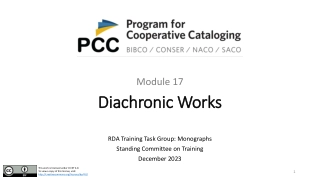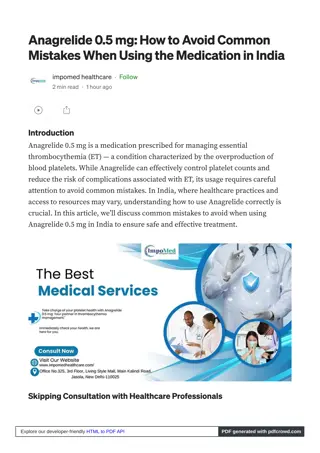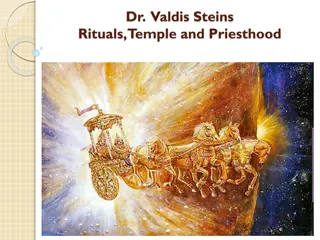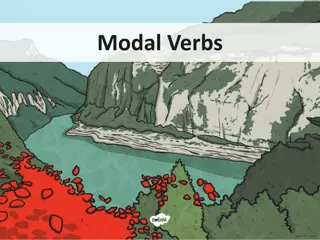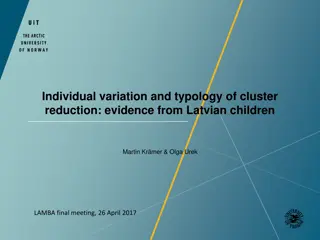Study on Vitality of Primary Latvian Verbs: A Diachronic Analysis
Primary Latvian verbs are derived from roots preserved in verbs, nouns, or adjectives. Some verbs have disappeared, and factors like semantics and morphology may have influenced their preservation. The study analyzed 461 primary verbs to understand the reasons behind their preservation or disappearance.
Download Presentation

Please find below an Image/Link to download the presentation.
The content on the website is provided AS IS for your information and personal use only. It may not be sold, licensed, or shared on other websites without obtaining consent from the author. Download presentation by click this link. If you encounter any issues during the download, it is possible that the publisher has removed the file from their server.
E N D
Presentation Transcript
ON VITALITY OF PRIMARY LATVIAN VERBS A PILOT DIACHRONIC STUDY
PRIMARY VERBS Primary verbs are derived not from other words, but from roots preserved either in verbs or as well in nouns or adjectives [M sdienu latvie u liter r s valodas gramatika. I. da a. Fon tika un morfolo ija, lpp. 332]. b. *tum > v. tumst to get dark n. tumsa darkness adj. tum s dark Also: verbs that are formed from the same root but differ in vocalism: birt to pour, to run out | b rt to pour, to strew lauzt to break | l zt to break, to crack'
WHY DID SOME PRIMARY VERBS DISAPPEAR? Most disappeared verbs had ordinary, still actual meanings: *b t to push *dirt to spread (out) *gozt to curve *kalt to speak etc. -> Not semantics of the verb was the main factor for disappearance.
WHY DID SOME PRIMARY VERBS DISAPPEAR? In the Dictionary of Latvian Etymology the possible reason for the disappearance is the conflict of homonyms (about 20 cases): *d t to say replaced by d t to put *salt to get sweet replaced by salt to get cold etc. Question that cannot be answered: How exactly did homonyms compete with each other? What influenced the disappearance of one of them frequency, semantic properties or something else? Is any other reason for the disappearance?
WHY DID SOME PRIMARY VERBS DISAPPEAR? Purpose of the study Which factors influenced the preservation or disappearance of primary verbs of the Latvian language? Hypothesis The semantic and morphological properties of the derivatives could influence the disappearance or the preservation of primary verbs. Material 461 primary verbs from the Dictionary of Latvian Etymology were analysed in terms of their current status, productivity, and semantics of their derivatives.
EXAMPLE OF INFORMATION Primary verb braukt *to rub; to go *dert to tear, to split Derivatives brauc t to rub , dar t to do , brauk t to go der t to suit Suffixes - t; - t - t; - t Conjuction of derivatives 3d 2nd 3d Historical meanings iterative causative; iterative Status of the verb preserved disappeared (reconstruction)
STATUS OF THE VERB Status of the verb Number % preserved 282 61,2 disappeared 179 38,8
MEANINGS OF DERIVATIVES Meanings % of meanings iterative 62,0 causative 31,1 durative 4,1 intensive 2,8 Due to the small number of durative and intensive meanings, these meanings were further ignored. This decision corresponds with the modern division of suffixal verbs into two groups: causative and iterative [M sdienu latvie u liter r s valodas gramatika. I. da a. Fon tika un morfolo ija, lpp. 332 333].
MEANING OF DERIVATIVES - 2 Meanings % of verbs iterative 59,9 causative 23,6 iterative + causative 16,5
SHORTCOMINGS OF THE DATABASE 1. Obviously, not all derivatives were included in the dictionary. 2. Phonetic doublets such as br z t to rush , br t to rush .
EXAMPLES OF DERIVATIONAL MEANS berzt to rub > berz t to rub - t *dzent to chop, to hack > dzen t to chop, to hack - t birt to pour, to run out > b rt to pour, to strew , birdin t suffixless; -in t to pour, to strew , dial. birin t to pour, to strew * elt to rinse > skalot to rinse , skalin t to rinse -ot; -in t In total, 32 combinations of derivational means.
In general, derivational properties of disappeared and preserved verbs are very similar, but the variety of derivational means for the latter is slightly greater. <- lack of information about disappeared verbs? <- more productive verbs had a greater chance to survive?
To test working hypothesis, contingency tables were created for variables the number of derivational means , meanings of derivatives , suffixes of derivatives , verb status (IBM SPSS Statistics).
RESULTS No statistical correlation between the variables verb status vs. the number of derivational means . However, with an increase in the number of word-forming means, there is a tendency to preserve the verb.
RESULTS Statistically significant correlation for variables verb status vs. meanings of derivatives : 2=10,020, df=2, p<0,05. Verbs with causative derivatives more often were preserved, while verbs with iterative derivatives and with derivatives of both groups of meanings more often disappeared.
RESULTS A separate analysis for the meanings iterative and causative also showed significant results: 2=8,830, df=1, p<0.05 (the presence of iterative derivatives correlates with the disappearance of the verb); 2=3,262, df=1, p<0.05 (the presence of causative derivatives correlates with the preservation of the verb).
DISCUSSION The results indicate that there is a connection between the meaning of derivatives and the survival of the primary verbs, but they do not mean a causal relationship and they are not an interpretation in themselves. Obviously, the vitality of each particular verb could be influenced by a number of factors interacting with each other in a complex way.
RESULTS Statistically significant results were also obtained for individual suffixes: 2=6,990, df=1, p<0.05 (the presence of derivatives with the suffix - t correlates with the disappearance of the verb); 2=4,818, df=1, p<0.05 (the presence of derivatives with the suffix -in t correlates with the preservation of the verb); 2=5,283, df=1, p<0.05 (the presence of derivatives with the suffix - t correlates with the preservation of the verb).
RESULTS Statistically significant results were also obtained for individual suffixes: 2=6,990, df=1, p<0.05 (the presence of derivatives with the suffix - t correlates with the disappearance of the verb); 2=4,818, df=1, p<0.05 (the presence of derivatives with the suffix -in t correlates with the preservation of the verb); 2=5,283, df=1, p<0.05 (the presence of derivatives with the suffix - t correlates with the preservation of the verb). most derivatives have an iterative meaning most derivatives have an iterative meaning most derivatives have a causative meaning
PERSPECTIVES The strength of the semantic relationship? a)causative derivatives dzimt to be born -> dzemd t to give birth clear connection b) iterative derivatives dust hard to breathe -> dus t to sleep' meanings are too different niezt to scratch -> niez t to scratch meanings are hard to distinguish
CONCLUSION The vitality of primary verbs correlates with the semantic properties of their derivatives: primary verbs with iterative derivatives disappeared more often than primary verbs with causative derivatives. There was no statistically significant correlation between the vitality of a verb and the morphological properties of verb s derivatives, however, the preserved verbs are characterized by a slightly greater variety of word-formation means compared to the disappeared verbs.


